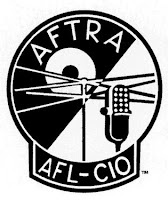It’s sheer idiocy that so many of my fellow actors cannot qualify for health insurance and benefits these days. Many factors contribute to this dilemma, including rising out-of-state production and a lack of production investment funds due to the Great Recession, but the most ridiculous of these is the work division between SAG and AFTRA.
For those who do not know, most professional actors work under the aegis of three major unions. The Screen Actors Guild (SAG) claims exclusive jurisdiction over film [motion picture] productions and originally extended this concept to claim jurisdiction over television programming filmed and edited in the manner of a motion picture. For this reason, prime-time sitcoms and dramas were produced under SAG contracts. The American Federation of Television and Radio Artists (AFTRA) claims jurisdiction over recording artists, radio personalities, and live-event or broadcast television. For this reason, day-time Soap Operas (which were originally made live) and live-audience taping shows (e.g. Rules of Engagement, Wheel of Fortune, and much of Disney and Nickelodeon) were produced under AFTRA contracts. The third union governs stage theatre and is called Actor’s Equity Association (AEA).
These three unions, among others, were all part of the Associated Actors and Artistes of America, a member of the AFL-CIO whereas the trade unions themselves were not. It is interesting to note that as of 2008, AFTRA became a direct affiliate of the AFL-CIO after some rather nasty disagreements with SAG. It is these disagreements, in fact, that sparked the unfortunate work situation that I’m railing against. SAG hardliners pushed for a strike in 2008 instead of negotiating a contract alongside AFTRA to allow actors to get back to work in the middle of the Great Recession. SAG then vilified and attacked AFTRA for backing out and negotiating alone. Meanwhile, AFTRA had a current contract and was able to sign shows for the next pilot season, which enabled them to snag the lion’s share – 83% – of the pilots picked up.
Therefore, instead of working primarily SAG contracts and earning enough days or income to qualify for health and benefits, my fellow actors and I have spent the last year splitting our earnings between a slew of new AFTRA projects and the remnants of SAG’s longstanding contracts. Thereby not quite meeting either AFTRA’s or SAG’s benefit requirements. And this after the year of the Writer’s Guild Strike and the de facto SAG strike (producers would not release funds for new SAG projects if there was a possibility the production would be shut down by a pending strike).
 Amazingly, even some of the actors being hit by this work division resist a merger between SAG and AFTRA. The primary complaint I hear is, “The AFTRA conditions and benefits aren’t as good as the SAG conditions and benefits; they’ll bring us down to their level. Ugh.” My response is, “Can you do math?” SAG boasts roughly 120,000 members, and AFTRA sports roughly 70,000. Of these, roughly 44,000 are dual-members. This means that a merger would effectively import only 26,000 new AFTRA members into a joint union. The majority of voters and board members would still be SAG originals and would still vote and negotiate for the same great conditions. Additionally, benefits are negotiated on purchasing power. A 146,000-member union would secure better benefits from a provider than a 120,000-member union.
Amazingly, even some of the actors being hit by this work division resist a merger between SAG and AFTRA. The primary complaint I hear is, “The AFTRA conditions and benefits aren’t as good as the SAG conditions and benefits; they’ll bring us down to their level. Ugh.” My response is, “Can you do math?” SAG boasts roughly 120,000 members, and AFTRA sports roughly 70,000. Of these, roughly 44,000 are dual-members. This means that a merger would effectively import only 26,000 new AFTRA members into a joint union. The majority of voters and board members would still be SAG originals and would still vote and negotiate for the same great conditions. Additionally, benefits are negotiated on purchasing power. A 146,000-member union would secure better benefits from a provider than a 120,000-member union.
These are just a few reasons for a SAG-AFTRA merger. I hope that you will share this post with your acting friends, as something really needs to be done about this. Please respond if you have other points to add or arguments against such a merger!
Anyone who likes this post ought to check out Digital Media Law, a blog by Jonathan Handel that is informative, well-supported, and well-connected (and from which I drew my inspiration and a few facts).

 It’s sheer idiocy that so many of my fellow actors cannot qualify for health insurance and benefits these days. Many factors contribute to this dilemma, including rising out-of-state production and a lack of production investment funds due to the Great Recession, but the most ridiculous of these is the work division between SAG and AFTRA.
It’s sheer idiocy that so many of my fellow actors cannot qualify for health insurance and benefits these days. Many factors contribute to this dilemma, including rising out-of-state production and a lack of production investment funds due to the Great Recession, but the most ridiculous of these is the work division between SAG and AFTRA.
Recent Comments